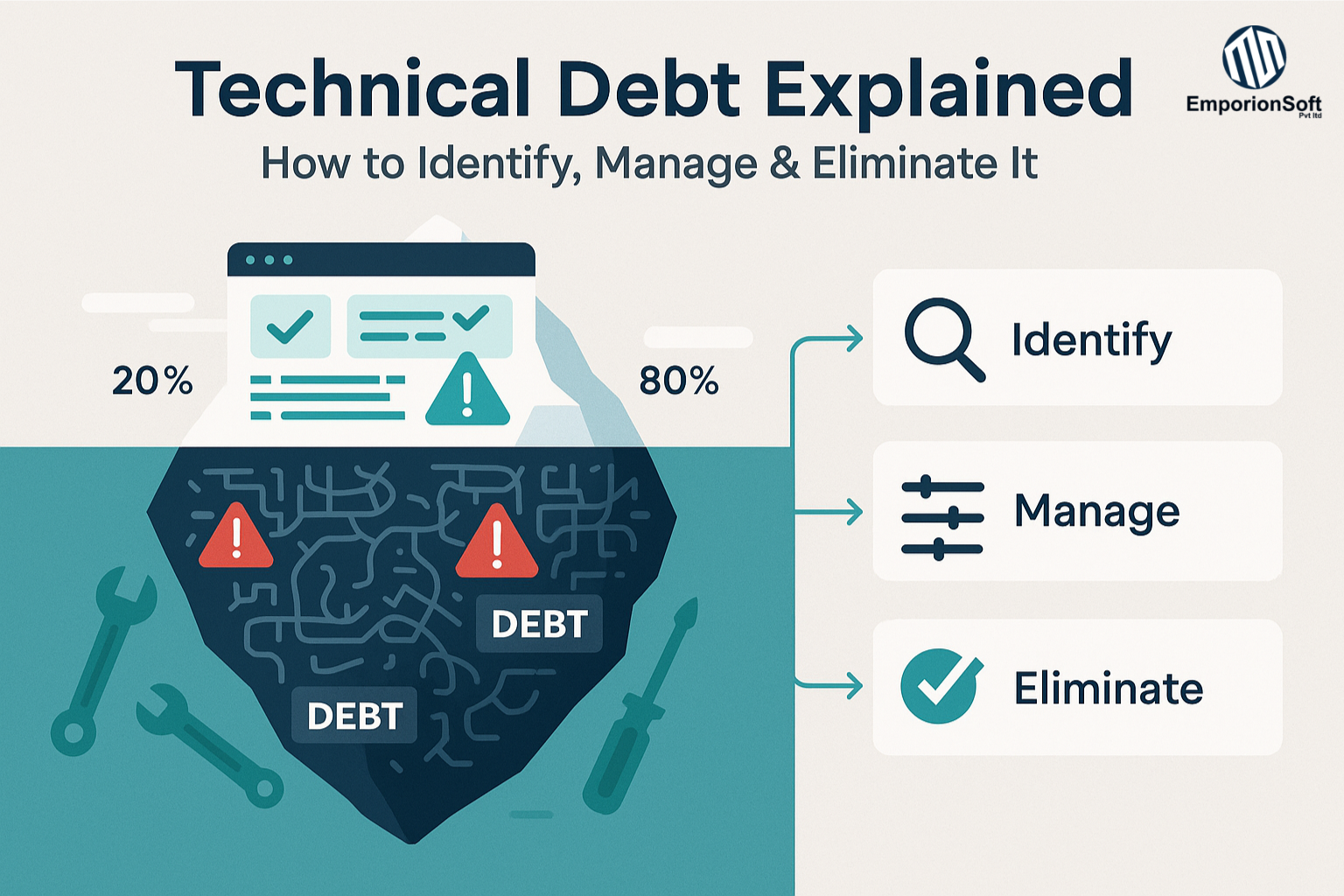The Snowball Effect: When Technical Debt Breaks Your Business
Companies waste 42% of development time fixing debt-related issues instead of building new features—that’s nearly half your engineering budget lost to preventable problems. Technical debt isn’t just a technical concern; it’s a business risk that escalates silently until systems fail, deadlines collapse, or customers revolt.
At EmporionSoft, we’ve seen how unmanaged debt can derail projects. One client’s e-commerce platform, for example, lost £250k/hour during a Black Friday crash—all because of outdated payment code that hadn’t been refactored for years.
Financial Consequences: The Hidden Tax on Your Productivity
1. Delayed Releases & Missed Opportunities
-
Teams bogged down by debt move slower. A 2023 Stripe study found debt-heavy codebases ship features 58% slower.
-
Example: A fintech startup delayed its open banking integration by 6 months due to spaghetti code, losing first-mover advantage.
2. Rising Maintenance Costs
-
Legacy systems demand 3–5x more effort to modify than clean code (IEEE research).
-
Tech debt ROI becomes negative: Every £1 “saved” by cutting corners costs £5 later in fixes.
3. Talent Attrition & Hiring Challenges
-
Top engineers leave chaotic codebases. A Glassdoor survey tied 40% of developer resignations to poor code quality.
-
New hires take months longer to onboard into tangled systems, increasing ramp-up costs.
Reputational and Operational Risks
1. High-Profile Failures & Outages
-
Case Study: In 2012, Knight Capital lost $460 million in 45 minutes due to unreplaced legacy code in their trading system. The company collapsed within months.
-
Similar debt-fueled disasters hit British Airways (2017 outage: £58m loss) and TSB (2018 IT meltdown: £330m remediation).
2. Security Vulnerabilities
-
Outdated libraries (like Log4j) expose systems to breaches.
-
60% of cyber incidents trace to unpatched technical debt (Verizon DBIR 2025).
3. Lost Customer Trust
-
Buggy apps = churn. 73% of users abandon apps after 3 crashes (Dimensional Research).
-
Example: A major UK retailer’s app ratings plummeted to 1.5 stars after checkout failures from unaddressed debt.
The Tipping Point: When Debt Becomes Unsustainable
Technical debt follows the “boiling frog” effect—teams adapt to worsening conditions until crisis hits. By then:
-
Refactoring costs 10–100x more than proactive fixes.
-
Competitors with cleaner code outpace you.
Don’t wait for disaster. Our project management tools guide explains how to track debt before it escalates. If you’re already in crisis? Contact EmporionSoft for emergency technical triage.
How to Spot Technical Debt Before It Cripples Your Project
Not all technical debt is obvious—some lurks in plain sight. You might have a functioning application today, but beneath the surface, accumulating debt could be silently eroding your software’s stability, scalability, and security. The key to managing technical debt isn’t just fixing it—it’s identifying it early before it escalates into a crisis.
At EmporionSoft, we’ve audited dozens of codebases and found that the most damaging technical debt often goes unnoticed until it’s too late. In this section, we’ll break down the warning signs, detection methods, and tools that help teams uncover hidden debt before it derails their projects.
5 Red Flags Your Codebase Has Debt
Technical debt manifests in different ways. Here are the most common symptoms:
1. Slow Performance & Frequent Bottlenecks
-
Does your application take longer to load with each update?
-
Are database queries or API responses getting sluggish?
-
Why it matters: Poorly optimized code, inefficient algorithms, or unrefactored legacy systems slow down performance over time.
2. Rising Bug Counts & Regression Issues
-
Are the same bugs reappearing after “fixes”?
-
Do small changes unexpectedly break unrelated features?
-
Why it matters: Spaghetti code, tight coupling, or lack of automated tests make systems fragile.
3. Developer Frustration & High Turnover
-
Is your team constantly complaining about “the mess” in the code?
-
Are new hires taking too long to onboard because the system is confusing?
-
Why it matters: A 2023 Google engineering study (DoFollow) found that poor code quality is a top reason engineers leave jobs.
4. Fear of Touching Legacy Code
-
Are certain parts of the system labeled “Here be dragons” because nobody dares modify them?
-
Do developers avoid refactoring critical modules due to risk?
-
Why it matters: Untested, undocumented legacy code becomes a maintenance time bomb.
5. Inconsistent Architecture & Duplicate Code
-
Are there multiple ways of doing the same thing across the codebase?
-
Is copy-pasted logic scattered everywhere?
-
Why it matters: Inconsistent patterns increase cognitive load and make scaling harder.
Tools to Diagnose Hidden Debt
Spotting technical debt requires more than gut feeling—it needs data-driven analysis. Here are the best methods and tools to uncover hidden issues:
1. Code Reviews & Pair Programming
-
Manual inspections catch bad practices early.
-
Pair programming helps share knowledge and reduce knowledge silos.
2. Static Code Analysis (SonarQube, ESLint)
-
Tools like SonarQube scan for:
-
Code smells (poor structure, overly complex methods).
-
Security vulnerabilities.
-
Tech debt metrics (estimated repair time).
-
3. Legacy System Audits
-
Identify outdated dependencies (e.g., unsupported libraries).
-
Check for deprecated APIs that could break in future updates.
4. Monitoring & Performance Profiling
-
APM tools (New Relic, Datadog) track slowdowns in real time.
-
CPU/memory profiling reveals inefficient code paths.
5. Team Retrospectives & Debt Tracking
-
Regularly discuss tech debt in sprint retrospectives.
-
Use Jira or GitHub Issues to log and prioritize debt items.
Next Steps: From Detection to Action
Identifying technical debt is just the first step—what you do next determines whether it becomes manageable or catastrophic. In our next section, we’ll explore the real cost of ignoring technical debt, from financial losses to security risks.
If your team is struggling with hidden debt, EmporionSoft’s technical consultation can help assess your codebase and create a remediation plan. For more insights on modern development challenges, check out our guide on How AI is Revolutionizing Software Development.
The Snowball Effect: When Technical Debt Breaks Your Business
Companies waste 42% of development time fixing debt-related issues instead of building new features—that’s nearly half your engineering budget lost to preventable problems. Technical debt isn’t just a technical concern; it’s a business risk that escalates silently until systems fail, deadlines collapse, or customers revolt.
At EmporionSoft, we’ve seen how unmanaged debt can derail projects. One client’s e-commerce platform, for example, lost £250k/hour during a Black Friday crash—all because of outdated payment code that hadn’t been refactored for years.
Financial Consequences: The Hidden Tax on Your Productivity
1. Delayed Releases & Missed Opportunities
-
Teams bogged down by debt move slower. A 2023 Stripe study found debt-heavy codebases ship features 58% slower.
-
Example: A fintech startup delayed its open banking integration by 6 months due to spaghetti code, losing first-mover advantage.
2. Rising Maintenance Costs
-
Legacy systems demand 3–5x more effort to modify than clean code (IEEE research).
-
Tech debt ROI becomes negative: Every £1 “saved” by cutting corners costs £5 later in fixes.
3. Talent Attrition & Hiring Challenges
-
Top engineers leave chaotic codebases. A Glassdoor survey tied 40% of developer resignations to poor code quality.
-
New hires take months longer to onboard into tangled systems, increasing ramp-up costs.
Reputational and Operational Risks
1. High-Profile Failures & Outages
-
Case Study: In 2012, Knight Capital lost $460 million in 45 minutes due to unreplaced legacy code in their trading system. The company collapsed within months.
-
Similar debt-fueled disasters hit British Airways (2017 outage: £58m loss) and TSB (2018 IT meltdown: £330m remediation).
2. Security Vulnerabilities
-
Outdated libraries (like Log4j) expose systems to breaches.
-
60% of cyber incidents trace to unpatched technical debt (Verizon DBIR 2025).
3. Lost Customer Trust
-
Buggy apps = churn. 73% of users abandon apps after 3 crashes (Dimensional Research).
-
Example: A major UK retailer’s app ratings plummeted to 1.5 stars after checkout failures from unaddressed debt.
The Tipping Point: When Debt Becomes Unsustainable
Technical debt follows the “boiling frog” effect—teams adapt to worsening conditions until crisis hits. By then:
-
Refactoring costs 10–100x more than proactive fixes.
-
Competitors with cleaner code outpace you.
Don’t wait for disaster. Our project management tools guide explains how to track debt before it escalates. If you’re already in crisis? Contact EmporionSoft for emergency technical triage.
Taming the Beast: Practical Ways to Control Technical Debt
Technical debt isn’t evil—it’s about balance. Just like financial debt, strategic borrowing can accelerate growth, but reckless accumulation leads to ruin. The key difference? Proactive teams manage technical debt before it manages them.
At EmporionSoft, we’ve helped global teams transform debt from a crisis into a controlled variable. The secret? Building systems that track, prioritize, and prevent debt—without sacrificing agility.
Building Debt into Your Workflow
1. Refactoring Sprints: The “Interest Payments” Approach
-
Dedicate 10-20% of each sprint to debt reduction (e.g., Google’s “20% time” model).
-
Example: A SaaS company reduced bug reports by 65% after instituting bi-weekly refactoring sprints.
-
Tools: Use Jira plugins like Stepsize to tag debt items during regular development.
2. Debt Tracking: Make It Visible
-
Tech Debt Register: Maintain a living document (or Confluence page) listing:
-
Known issues
-
Severity scores
-
Estimated fix time
-
-
Visual Dashboards: Tools like SonarQube or CodeClimate quantify debt with metrics (e.g., “Days of Debt”).
3. Documentation Standards: Prevent Knowledge Rot
-
Enforce “Docs-as-Code”: Treat documentation like testable requirements.
-
Onion Architecture: Document decisions at each layer (why a shortcut was taken, expiry date).
Preventing Debt Accumulation
1. Leadership’s Role: Budget for Maintenance
-
Allocate 15-30% of dev time to maintenance (per Microsoft’s DevOps Guide (DoFollow)).
-
Metrics That Matter: Track:
-
Code churn (files changed repeatedly = instability)
-
Cycle time (how long fixes take)
-
2. Quality-First Culture
-
Peer Reviews: Require 2+ approvals for merges.
-
Definition of Done: Include “No new debt” criteria (e.g., tests + docs).
3. Automated Safeguards
-
CI/CD Gates: Block merges if:
-
Test coverage < 80%
-
Static analysis finds critical smells
-
-
Tech Debt “Thermostat”: Fail builds if debt metrics exceed thresholds.
When to Take on Debt Strategically
Not all debt is bad. Intentional debt accelerates growth when:
✅ Launching MVPs (but schedule payback post-launch)
✅ Responding to emergencies (with a cleanup plan)
Pro Tip: Our guide on Adaptive Software Development shows how to balance speed and quality.
From Crisis to Clean Code: A Developer’s Debt Elimination Blueprint
Eliminating technical debt isn’t a sprint—it’s a marathon with checkpoints. Trying to fix everything at once is a recipe for burnout, but ignoring it guarantees disaster. At EmporionSoft, we’ve helped teams systematically eliminate technical debt while still delivering features—here’s our battle-tested approach.
How to Prioritise Debt Paydown
Not all debt is created equal. Use these frameworks to triage:
1. The Debt Quadrant (Martin Fowler)
| Reckless/Deliberate | Reckless/Inadvertent |
|---|---|
| Prudent/Deliberate | Prudent/Inadvertent |
-
Prudent/Deliberate: Strategic debt (e.g., MVP code). Schedule repayment.
-
Reckless/Inadvertent: Accidental bad code. Fix immediately.
2. ICE Scoring (Impact, Confidence, Ease)
-
Impact: How much will fixing this improve stability/performance?
-
Confidence: Are we sure this is the root cause?
-
Ease: Estimated effort to resolve.
Example: A legacy auth module with frequent security patches scores High Impact (9), High Confidence (8), Low Ease (3) → Prioritize despite difficulty.
3. The “Boy Scout Rule”
-
Leave code cleaner than you found it. Fix small debts during routine work.
Step-by-Step Elimination Plan
Phase 1: Assess
-
Audit Tools: SonarQube, CodeClimate, or EmporionSoft’s LLM-powered audits.
-
Debt Inventory: List all known issues with:
-
Severity (1–5)
-
Business impact (€)
-
Dependencies
-
Phase 2: Triage
-
Quick Wins: High-impact, low-effort fixes (e.g., deleting dead code).
-
Scheduled Refactors: Moderate effort (e.g., API normalization).
-
Long-Term Projects: Full rewrites (plan quarterly).
Phase 3: Refactor
-
Atomic Changes: Small, testable increments.
-
Strangler Pattern: Gradually replace legacy systems.
-
Document As You Go: Update docs for every change.
Phase 4: Test
-
Regression Tests: Ensure fixes don’t break existing features.
-
Mutation Testing: Verify test coverage validity.
Phase 5: Monitor
-
Dashboard Metrics: Track:
-
Code smells/week
-
Build stability
-
Mean time to repair (MTTR)
-
Automating Debt Prevention
1. CI/CD Gatekeepers
-
Block merges if:
-
Cyclomatic complexity > 10
-
Test coverage < 80%
-
New smells detected
-
2. Architectural Reviews
-
Bi-weekly reviews of new designs for:
-
Scalability risks
-
Dependency tangles
-
3. Debt “Weather Reports”
-
Monthly Slack digests showing:
-
Debt trendlines
-
Top 3 risks
-
Ready to Turn Technical Debt Into Technical Wealth?
Technical debt is inevitable—but unmanageable debt is optional. Throughout this guide, we’ve explored how to identify, assess, and systematically eliminate the hidden costs of rushed code and outdated systems. The difference between thriving projects and failing ones isn’t the absence of debt, but the strategy to control it.
At EmporionSoft, we’ve transformed crisis-level debt into clean, scalable systems for clients worldwide—from fintech startups to enterprise platforms. The key insight? Sustainable software requires treating debt as a managed resource, not an emergency.
Why EmporionSoft Is Your Ideal Partner
-
Proactive Debt Tracking:
-
Our custom dashboards automate debt detection using static analysis and AI (like our LLM-powered audit tools).
-
Real-time alerts prioritize risks before they escalate.
-
-
Proven Refactoring Frameworks:
-
We apply Strangler Patterns and micro-refactors to modernize systems without downtime.
-
See results in our case studies, like reducing a client’s bug backlog by 72% in 3 months.
-
-
Culture Overhaul Support:
-
Train teams to prevent new debt with:
-
Code review standards
-
Architectural guardrails
-
“Debt-aware” sprint planning
-
-
Your Next Step: Free Technical Audit
Don’t let debt decide your system’s future. Book a free technical audit with EmporionSoft to:
-
📊 Identify critical debts in your codebase
-
🎯 Receive a prioritized action plan
-
⚡ Learn how to save 30+ dev hours/month










